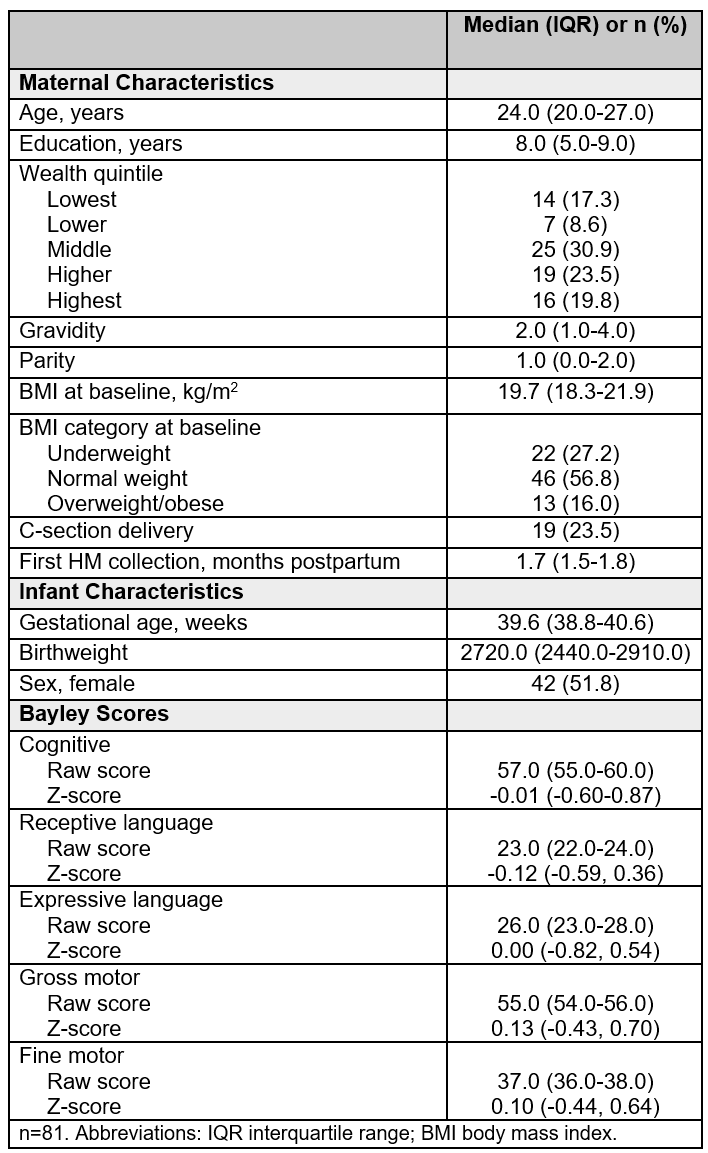Neonatology
Session: Neonatal Neurology 10: Neurodevelopment
362 - Associations between the Human Milk Metabolome and Child Neurodevelopment in Rural Bangladesh
Monday, May 6, 2024
9:30 AM - 11:30 AM ET
Poster Number: 362
Publication Number: 362.3145
Publication Number: 362.3145

Chloe Andrews, MS, RD (she/her/hers)
Project Manager/PhD Student
Women & Infants Hospital
Boston, Massachusetts, United States
Presenting Author(s)
Background: Human milk (HM) composition may underpin the beneficial effects of HM feeding on child neurodevelopment. Previous studies have identified specific components of HM that are associated with neurodevelopmental outcomes. However, data on the associations between the HM metabolome and neurodevelopment, especially in low-middle income country settings, is lacking.
Objective: To determine associations between HM metabolomic profiles at one month postpartum and child cognitive, language, and motor development at two years.
Design/Methods: We conducted a longitudinal sub-study of 81 breastfeeding mother-infant dyads from the Projahnmo pregnancy cohort in Sylhet, Bangladesh. Mothers self-collected HM samples mid-feed at one month postpartum. We quantified HM metabolites using untargeted mass-spectrometry and used principal component analysis to consolidate the 568 metabolites into eight factors, which accounted for 46% of the variance. Trained research staff administered the Bayley III at two years. We calculated cohort specific z-scores in the cognitive, receptive communication, expressive communication, gross motor, and fine motor domains. We determined associations between the metabolome factor scores and Bayley z-scores using linear regression adjusted for confounders. We used a Bonferroni-corrected alpha level of < 0.05/8 to account for multiple comparisons.
Results: Cohort characteristics are presented in Table 1. Median (IQR) maternal age was 24 (20-27) years, years of education was 8 (5-9), and gestational age at birth was 39.6 (38.8-40.6) weeks. The raw and z-score Bayley scores are presented in Table 1. In analyses adjusted for maternal education, parity, and infant gestational age, we observed a positive association between factor 7, composed mainly of caffeine metabolites (Table 3), and receptive communication z-scores (β 0.23; 95% CI 0.02, 0.45; p=0.034) (Table 2). This association was not significant at the Bonferroni-corrected alpha level. No other metabolite patterns were associated with child neurodevelopment.
Conclusion(s): HM characterized by high concentrations of caffeine-related metabolites may be associated with improved neurodevelopment in the receptive communication domain. As tea is the major source of caffeine intake in this population, these findings may be due to other beneficial components of tea, such as antioxidant polyphenols/catechins, that were not characterized in this HM metabolomic study. Future studies should investigate these associations in a cohort with detailed data on intake of polyphenols-containing foods and drinks.


.png)
